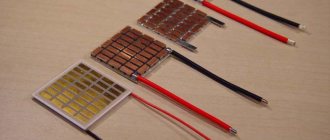Due to the improvement in the technical equipment of attackers, hacking or entering any premises today is only a matter of time, which in such situations is not on the side of the owner. To prevent unauthorized intervention, security alarms are now widely used as an effective means of preventing theft or reducing the extent of its consequences. How the alarm system works and what principles to follow when choosing it we will look at in this article.
Compound
A security alarm is a component of a complex of security systems designed to provide notification in the event of a violation of private property. The effectiveness of the system directly depends on the ability to assess penetration factors and transmit information about it. In accordance with clause 4.1. GOST R 52435-2015 the alarm system includes:
- Notification modules;
- Reception and control unit;
- Alert modules;
- Alarm control devices.
Rice. 1. Composition of a security alarm
Notification module
The notification module is a system of sensors that respond to changes in the parameter they measure (sound, movement, temperature, pressure, circuit integrity, etc.).
Rice. 2. Sensors for security alarms
Based on the principle of operation and purpose, there are a huge number of different categories of sensors, but the most commonly used sensors in security alarm systems are:
- Openings - a magnetic key/lock, one half of which is installed on the frame, and the second on the doors or window. When the latter are opened, the magnetic key moves away from the lock and opens the way for the signal to flow.
- Movements - perceive information about the state of the entire volume of premises and give a signal if there is any movement in space.
- Glass breakers – can be mounted both directly on glass and nearby. Most of these models respond to high- and low-frequency sound vibrations and vibration.
- Thermal - react to temperature fluctuations in space, since the temperature of the human body differs significantly from the environment.
If a sufficient level of the measured value occurs, the sensor converts it into an electrical signal, which is then transmitted via communication lines.
Reception and control unit
The receiving and control unit is used to take readings coming from sensor circuits. It collects and processes the received information and, if the signal data matches, it launches an alarm and notification algorithm. Typically, this unit contains an electronic controller programmed to operate on a number of incoming and outgoing communication lines.
Alert modules
Alert modules are designed to report intrusion or perimeter violation. To do this, they can transmit data to law enforcement agencies, security companies, display it or use other methods of influence. By type they are divided into the following types:
- Sound sirens are dynamic or piezoelectric sirens. Designed to scare intruders, cause panic and force them to leave the territory.
- Light - similar to the previous ones, but they have light effects. Depending on the method of influence, they can blink or simply turn on the light, simulating the movement of guards around the territory.
- Combined - combine sound and light methods of influence, are considered more effective due to increasing psychological stress in offenders.
- Telephone – transmit information via communication lines in the form of a recording to security organizations or an authorized department.
- Mobile – notify the owner and other structures about the incident via SMS notification.
- Telecontrol – provides data about an incident to a remote control or mnemonic panel.
In practice, not one, but several options are installed at once, which is why several data transmission channels are output from the receiving and control unit at once. In some security alarm models, logic can be set by priority or depending on influencing factors.
Control device
Security alarm control devices allow you to set an operating mode, activate or disable sensors, open doors or give a green light in certain situations.
For this purpose the following can be used:
- Keyboard with display – installed at checkpoints, indoors. Allows you to operate the security alarm by entering codes and commands.
Rice. 3. Keyboard with display
- A portable remote control or key fob allows you to change the configuration of work processes or interact with the security alarm in the friend or foe mode.
- The key is an original version of access through the system into the premises, into the territory of the facility. Cards, key tablets and other devices are used as keys.
Rice. 4. Using a tablet key
DIY laser alarm in a country house
Security systems with laser radiation are also popular. This alarm is triggered after an object enters the beam's coverage area.
Circuit diagram
The circuit for such a signaling can be made with the inclusion of a laser emitter and an NE555 timer, which controls the functioning of all elements of the system. A photoresistor is usually used as a laser receiver, in which, during irradiation, a small resistance is created, and in its absence, changes occur in a larger direction, which leads to the inclusion of an audio signal.
Due to the complexity of the circuit, installing the system may seem difficult
Installation of an alarm system with a laser pointer
For this alarm to work, you will need to install:
- a laser pointer that generates a beam;
- photocell, that is, a device with varying resistance;
- a relay connecting the system elements with the siren;
- fasteners for installation;
- body parts;
- switching conductors;
- tools and materials for soldering wires and parts.
Installation of a laser security system is carried out as follows:
- The relay contacts are connected to the wires coming from the sound siren and photocell, and the power line of the emitter.
- The laser, which emits a special light, and the receiver are mounted parallel to each other so that the beam goes to the center of the photocell. In this case, the sensor is placed in a black tube in order to close it from light sources in the room.
The beam from the device acts as a sensor
- The button responsible for turning on and off the system, and the wires are positioned so that they are not visible, otherwise attackers will be able to extinguish the alarm signal.
The button is mounted opposite the device producing the beam
Advantages and disadvantages of the laser system
The advantages of laser alarms include:
- high mobility, because elements of the system can be easily moved to another place;
- secrecy from intruders;
- the ability to connect to both a siren and a security company remote control;
- using improvised means to create a system.
Among the disadvantages of laser signaling are:
- high cost of parts;
- difficulties in installation and configuration.
Principle of operation
Let's simulate a situation when some movement occurs in a protected space. The motion sensor will detect movement in the coverage area and send a signal via communication lines to the receiving and control unit. Here the received data will be processed and sent via loops to the executive body. The warning module will begin to turn on the lighting in the area and start a siren or strobe light.
Fig.5. The principle of operation of the security alarm
If the security alarm is connected to the security post or is displayed on the police console to the duty officer, then the data will be sent via the mobile channel to the authorized structures. In addition, information can be transmitted to the owner’s mobile phone through an SMS alert system or through a specialized mobile application.
The security alarm can be turned off using a separate button or by entering a special command code to stop. The system is triggered in a similar way by any other type of notification module.
Electrical diagram for connecting sensors to alarms
Detectors come with two or three external contacts. The difference between the first ones is internal or battery power, and they are included in the circuit to break the warning control circuit. The use of such security systems implies the presence of internal converters of the detector signal into an initiating pulse. If they are missing, an external controller is used.
Three wired ones - two contacts are used to power the sensor, and the third is used to send an impulse to the notification device.
The switch on the circuit is designed to block its functionality during periods when the operation of the security system is not desired. For example, while the owners are indoors. The switch is installed in an inconspicuous place.
Instead of a signaling device, in large security complexes, it is connected to a control panel or central unit, the automation of which already turns on the sound alert, or uses other methods to eliminate illegal presence in the premises.
With two-wire sensors, the system will be slightly different. It initially implies the presence of autonomous power supply.
The above diagram uses the OSA-1 control unit, but any of the similar ones can be used. The structure of the structure will not change because of this, only the location of the outputs may be different.
Types
Security alarms are developed and implemented according to certain templates of technical specifications. The implementation of solutions to certain problems is carried out through systems of a certain type. Depending on the criterion, several types are distinguished; thus, according to the method of influence, there are two types:
- Active - have a direct impact on robbers by attracting security, alerting law enforcement agencies, and other methods of influence.
Rice. 6. Active type of security alarm
- Passive - create a number of effects designed to scare away intruders. This includes light, sound and other impacts that occur within protected objects.
Depending on the type of communication lines through which information about an incident is transmitted, there are two large categories - wired and wireless models.
Wired systems are divided into:
- Analog - transmit information through a loop over a wire to a specific notification point. They are a cheap, but uninformative system.
- Addressable - has an assigned address for each object, the information is processed by a microprocessor and transmits a signal about a specific sensor to the operator.
Wireless security alarms can also be divided into several groups, depending on the transmission channels:
- By radio signal - uses radio transmission devices to send an alarm signal, can be done with or without feedback;
- Via mobile channels – uses modems with classic or specialized SIM cards;
Rice. 7. Mobile transmission
- Via Wi-Fi signal – uses Internet resources to send alarm protocols.
Sensors
A reliable security alarm system also uses motion detectors, which are triggered as soon as an object is within the detection zone of the sensor. These devices come in different types, but for private security alarm systems, passive infrared motion detectors are used. They are cheaper than radio wave microwave sensors and more reliable than ultrasonic ones. Each sensor has a clearly defined detection zone.
Most infrared motion sensors have a zone length of 10-12 meters and a capture angle of 900.
Typically, such devices are installed according to the principle of one room, one sensor, but there are exceptions. If a room has several windows located on one wall, then an infrared “curtain” detector is installed, which forms a narrow vertical but extended horizontal zone that blocks all windows along the wall.
Sound (acoustic) sensors respond to the sound of breaking glass. They form an additional security line. As a result of installing three types of sensors, the room will be completely blocked and entry into it through the window and door is almost impossible. Vibration sensors respond to attempts to undermine or destroy (break) a wall and are used extremely rarely in household security alarms.
Sirens
In addition to sensors, any security alarm system must have a warning device. Most often, a low-current siren is used, combined in one housing with an LED indicator. Such a device, in case of violation, emits a sharp signal with a sound pressure from 90 to 115 dB, which will simply scare away the intruder. In addition, the sound of the siren along with the red flashes of the LED indicator will attract the attention of neighbors.
Power alarm
For reliable and uninterrupted operation of the security alarm system, care should be taken to ensure proper power supply.
Power outages require the use of power supplies with built-in batteries in security systems. Such devices allow the alarm to function normally for several hours. To perform installation work you will need a wire, cable duct and fasteners. The security alarm is wired using KSPV 4 X 0.5 wire. Two of the four wires are used to supply power to the sensors, and two more form a signal loop. To connect the network, use a ShVVP wire or similar. Installation of sensors and laying of the cable channel is carried out using dowels and self-tapping screws.
PKP - the heart of the security alarm system
The basis of the security alarm system is the control panel - PKP . For a simple security system, it is enough to use a device with one or two loops. Such a device is inexpensive, but has well-developed functionality and is perfect for a small apartment alarm system.
Common devices with one loop:
- Quartz
- Astra 712/1
- VERS-PK 1
The cost of the devices does not exceed 1900 rubles. The case of each device has a place for installing a battery. Arming and disarming is carried out using Touch Memory electronic keys, which are included in the delivery package.
Video on how to make an alarm from your phone:
Security alarm features
Before choosing a specific model, it is important to determine the main characteristics of the protected object. Namely, you must inspect the premises or territory to identify the most likely points of entry, points of storage of valuables, documents, etc. Determine where the control unit will be installed, the distance to the sensors and source elements, and whether communication will be established with the dispatch console.
For a private home.
In a private home, it is important to install both wired and wireless security alarm systems. It is important to note that control is established both inside the house and outside: at the entrance, near the gate, along the perimeter of the fence, etc. Along with classic security modules, the “smart home” option is gaining popularity today, which also provides the ability to control the open/closed position of windows and doors, program the reaction of sensors to movement in rooms, and much more. It also allows video surveillance of both individual rooms and the surrounding area.
For an apartment.
Depending on the size of the apartment, the area of the rooms and the number of windows, you can install a passive system that responds immediately throughout the entire home or an active system that transmits burglary data to the control panel. It is desirable that the security alarm monitors all rooms without exception; the coverage also includes loggias, balconies, storage rooms and other components through which penetration is possible. For small areas, you can use autonomous alarms that work only inside the apartment.
For the dacha.
The main difficulty of a summer cottage is its remoteness from the owner and, possibly, from a populated area, which significantly complicates the process of going to the site and actively responding. Therefore, a passive security alarm system that outputs data via a GSM channel to the owner’s phone is relevant for a dacha. It is also important to trigger light and sound alarms to scare away intruders.
For the office.
Rice. 8. Organization of an alarm system in the office
If the premises for an office are rented, then using a wired security alarm system is not practical; it is much more profitable to install devices that operate via wi-fi or a radio signal. In office settings, a video surveillance system is a good help, which, in addition to security functions, will help monitor the work of employees. Depending on the assigned tasks, the security alarm can have both active and passive versions. For example, in small buildings with departmental security or a watchman, a sounding siren will be enough to attract their attention.
Is a project necessary for homemade alarms (with cell phone, relay, laser)
Having decided to install a security system in a garage or other property, the first thing to decide is the development and execution of documents. The project, created by professionals, will help employees of a special company install an alarm system without any problems. True, the owners of houses who made the security system themselves are not sure that they need documentation.
An urgent need to create a project arises when installing a GSM alarm in a public place. Without documents, supervisory authorities will refuse to accept the object. But the security system in a house, garage, cottage or other privately owned property does not need to be shown to specialists. Therefore, you can do without design documentation by drawing up just a diagram of the location of the sensors.
Nuances of installation and assembly
Modern security alarm units can be easily installed by yourself, but some rules and nuances should be taken into account:
- If you install motion sensors, then you should take into account that in accordance with paragraphs 2.2.7 - 2.2.9 of GOST 26342-84, these devices have a gradation based on the volume of the room and the speed of movement of a person. Which you should consider when setting up protection.
- When choosing a wireless alarm, keep in mind that the coverage distance of the sensors depends on their technical parameters.
- When installing equipment outdoors, take into account the temperature conditions of your region, otherwise the security alarm may stop working at extremely low temperatures.
- If power surges occur, be sure to install a battery for uninterrupted operation.
- The fewer sensors you install, the less security alarm coverage and functionality you will have.
- Do not skimp on components; your safety and the safety of your property depend on their quality.
Pros and cons of different types of sensors
Sensors of one type cannot provide a complete guarantee of safety. Each type has its own strengths and weaknesses:
- Motion sensors. Despite their ease of use, they have several limitations. One of which is the coverage area, outside of which the sensor “sees” nothing. That is, an attacker can simply move outside the field of view of the sensor. In addition, a big and painful issue with such detectors is sensitivity. Each of their types has its own disadvantages. Optical ones operate only when there is sufficient lighting, infrared ones when an object with a high temperature appears in the perimeter, wave ones are unreliable, acoustic ones often react to external, parasitic noise.
- Detectors installed in indoor access points, while reliable, also have a number of disadvantages. Vibrational and linear ones can be bypassed simply by penetrating through the space not controlled by them. The same applies to magnetic ones. If only one type of detector is used - say, to open a window or door, then the attacker will enter anyway, simply making an entrance to the side.
- Perimeter. Laser ones are considered the most reliable, but they also have two disadvantages, one of which is the visibility of security beams using specialized equipment, which can facilitate their passage by changing the direction of their flow or bypassing them. The second is sensitivity to pollution. The installation locations of such systems are located within areas with the maximum amount of dust, which may affect their functioning. Induction, in turn, never had good sensitivity. Moreover, such a sensor will not work in cases where the offender is wearing a rubberized, non-conductive suit.
The most reliable will be the connection scheme for security sensors, which uses their maximum variety, both in physical principles of operation and installation locations.
What to choose?
Which manufacturer to choose
On the modern security alarm market there is a fairly large range of products from a variety of manufacturers. Therefore, next we will consider the most reliable and proven companies that operate on the market:
- Jablotron is a world-class manufacturer producing the latest security alarm equipment;
- Visonic Ltd is an Israeli manufacturer of security alarms that has held a leading position in the market for about half a century;
- SATEL is a Polish concern whose products are characterized by affordable prices and acceptable quality;
- Sapsan is a domestic manufacturer of security alarms; the devices are reasonably priced and well adapted to our conditions;
- Ajax is a relatively new company that has already proven itself to be the best in the market.
Frontiers of SOTS
An important concept when designing SOS and COTS is the security line. A security line is a group of detectors that gives an alarm at various stages (lines) of penetration into a protected object.
There are three lines of protection (defined by documents RD 78.36.003-2002 and RD 78.36.006-2005):
- First. At this stage, the protection of windows and doors, communication entry points and emergency exits is ensured.
- Second. This line protects the volume of the room using optical-electronic detectors.
- Third. Here the protection of safes and individual items, for example, exhibits in museums, is carried out.
We can also highlight a fourth line - alarm buttons used by employees in the event of an emergency situation, for example, a threat to life.
The numbering and number of milestones can be changed, because this parameter depends on the object and on the tasks assigned to the security system.
List of used literature
When writing this article, the following textbooks were actively used:
- O. M. Lepeshkin, V. V. Kopytov, A. P. Zhuk “Integrated security means and technical means of fire alarm systems” 2009
- Vorona V.A., Tikhonov V.A. "Technical security and fire alarm systems" 2018
- G.M. Punegov “Secrets of installing security systems” 2017
- Biryukova O.V. "Electronic alarm systems" 2015
- Gruba I.I. “Security alarm systems. Technical means of detection" 2012
Wired alarm components with GSM module
Having decided to assemble such a security system yourself, prepare:
- an old push-button telephone (for example, Nokia 3310) is the basis of the alarm system;
- sealed switch (reed switch);
- a regular charger that powers the battery (or a capacitive battery for a phone);
- long wire;
Along the chain, information about the hack reaches the button on the phone
- soldering iron;
- metal soldering material;
- magnet;
- additional SIM card.
The telephone must be a regular push-button one











